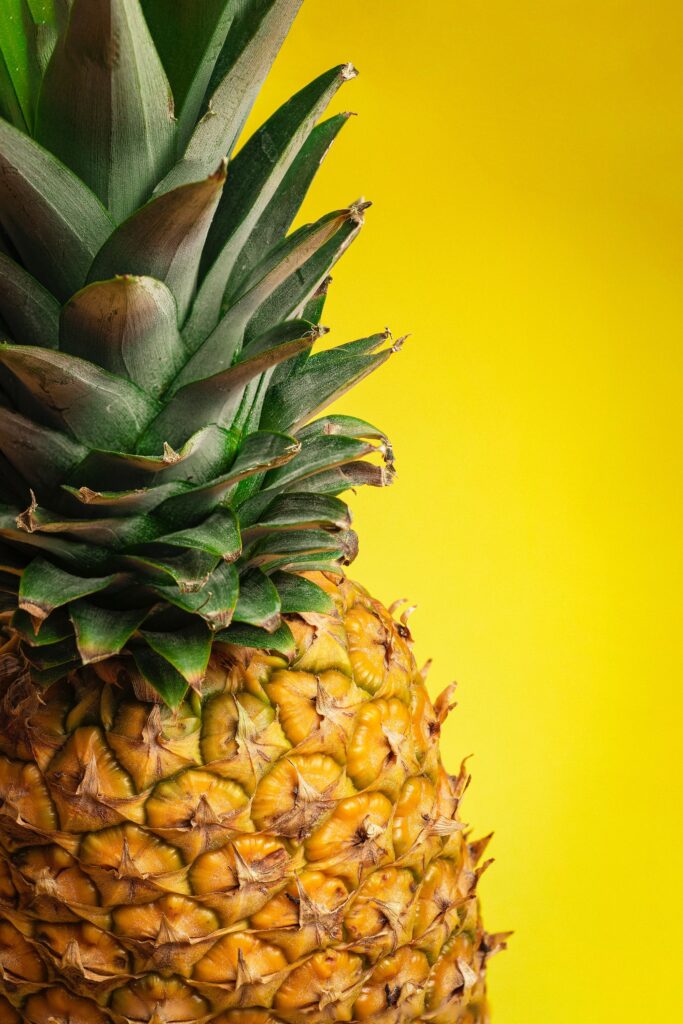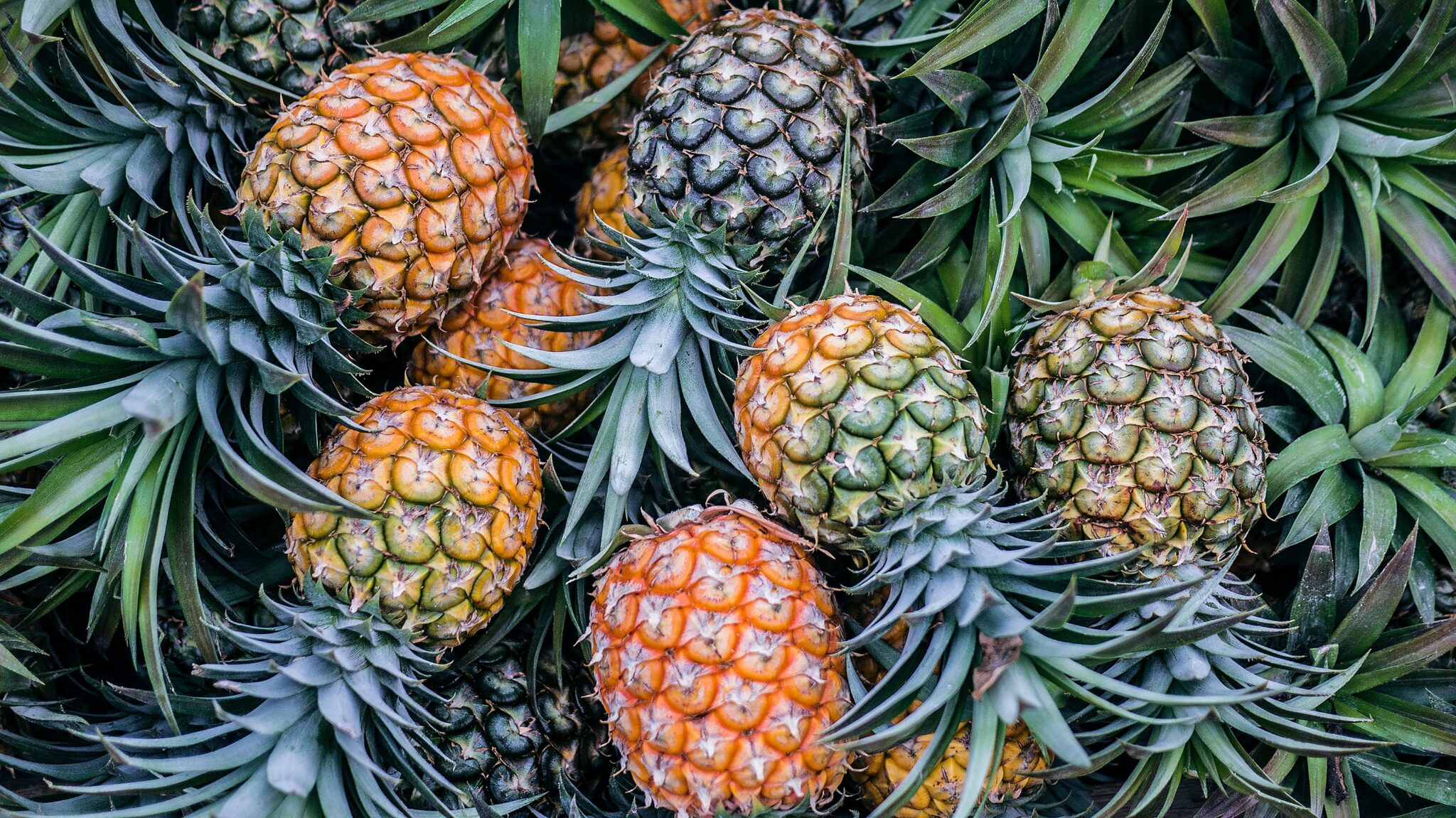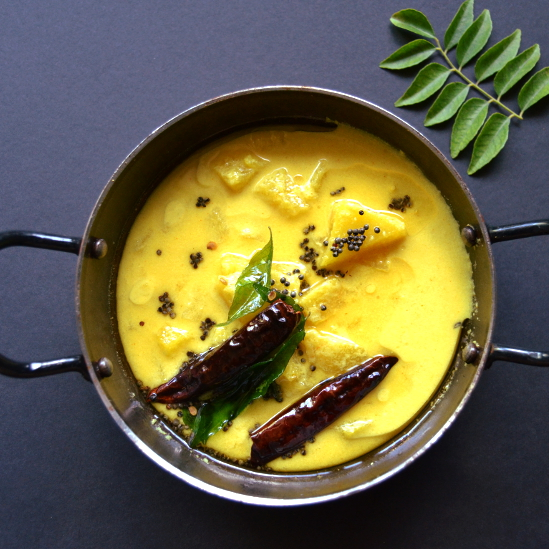Vazhakulam Pineapple, If you have tasted Pineapple ever in your life, you would have tasted this for sure…

Pineapple is one of the most popular tropical fruits, with a vibrant flavour, exceptional juiciness and immense health benefits. Scientifically called Ananas Comosus:Bromeliaceae, which can be roughly translated to “tufted, excellent fruit”, pineapple got its English name from its resemblance to a pinecone.
Pineapple has been a part of traditional medicine for centuries, obviously for its abundance of nutrients and antioxidants. Pineapple contains a considerable amount of dietary fibre and is an abundant source of Vitamin C, the reason why when ships set sail for long journeys, stack pineapples. Pineapple is nevertheless abundant in calcium and potassium as well. Additionally it is low in fat and cholesterol. It is also a good source of vitamin B1, vitamin B6 and copper. Pineapple can act as a digestive aid and has a natural anti-inflammatory property. Pineapples are primarily consumed as fresh fruit and/or in dried and canned form and/or often as juice.
This cylindrical-shaped, compound fruit develops from the fusing of many small fruits into one. The stem serves as the fibrous core to this juicy and fleshy fruit. The flesh colours from nearly white to yellow. A pineapple fruit can grow 30 cm long and can weigh anywhere around 0.5 to 4.5 kg or even more rarely. The waxy, hard rind may be dark green, yellow, orange-yellow or even reddish when the fruit is ripe.
Varieties found in Kerala
Vazhakulam pineapple (Kannara)
Kerala, God’s Own country, has its own local flavoured, GI tagged pineapple, known as the Vazhakulam pineapple. Known as ‘Kannara’, in local language, Vazhakulam pineapple belongs to the Queen variety.
An average Kannara fruit weighs around 1300-1600gms, with a pleasant and distinct aroma. These usually come in a slight conical shape, with its ‘eyes’ deeply placed.
The fruit’s flesh is golden yellow in colour and crisp. The juice of Kannara fruit is sweet with around 14-16 o brix and has an acidity of around 0.50 – 0.70%. It is a good source of carotene, vitamins, minerals and energy. Owing to its high sugar content and low acidity, Kannara stands out from other varieties in its unique aroma, flavour and sweetness.
Vazhakulam pineapple is registered as Geographical Indication (GI) No. 130 under Agricultural-Horticultural product at the GI Registry, Chennai, Tamil Nadu India.
MD-2
Commonly known as the MD-2, the golden extra sweet pineapple is a globally sought after variety of pineapple. MD-2 or Dinar pineapple is the standard for the international market because of its colour, flavour, shape, lifespan and sweetness when ripe.
This variety has a very high brix value (17 for ripe fruit) and low acidity (0.4-0.45%), medium fruit sizes (1.5 to 2.0 kg), cylindrical shape with sort of a square shoulder.
The core size of MD-2 is small and has an innate resistance to internal browning, and has a very long shelf life of around 30 days.
MD-2 is cultivated in Kerala, however in very small quantities.
Health Benefits
Pumped with Nutrients
Pineapple is a fruit with a very high nutritional value. Given here is the value of different nutrients in 100 grams of pineapple.- Energy – 52 Calories
- Carbohydrates – 13.7 gm
- Protein – 0.6 gm
- Fat – 1 gm
- Dietary Fibre – 1.4 gm
- Potassium – 150 mg
- Vitamin C – 24 mg
- Calcium – 16 mg
- Magnesium – 12 mg
- Phosphorus – 11 mg
- Iron – 0.28 mg
- Zinc – 0.10 mg
- Vitamin A – 130 I.U
- Vitamin B1 – 0.079 mg
- Vitamin B2 – 0.031 mg
- Vitamin B3 – 0.489 mg
- Vitamin B6 – 0.110 mg
- Vitamin K – traces
- Manganese – traces

Aids Digestion
Pineapple contains a group of enzymes (bromelain) that contain sulphur, which is capable of breaking down proteins (proteolytic). These enzymes aid in digestion. Pineapple is abundant in dietary fibre, which helps in aiding bowel movements. Pineapple is effective in getting rid of intestinal worms and also keeps the intestines and kidneys clean. It is effective in flushing out the toxins from the body, thus making the metabolism healthy.Contains various enzymes that prevents diseases
Bromelain, a complex mixture of substances that is extracted from the stem and core of pineapple, has demonstrated significant anti-inflammatory effects. Evidence suggests that Bromelain helps in reducing swelling in inflammatory conditions such as arthritis, acute sinusitis, sore throat, bronchitis and gout. It can as well aid in recovery from injuries and surgery. Lab tests have shown that Bromelain suppresses various cancer growths.
Enzymes found in pineapple have been used with success in the treatment of rheumatoid arthritis and diabetic ulcers. They can help in preventing blood clotting and can help in removing plaque from arterial walls. These enzymes are found to be excellent cerebral toners, which can help combat loss of memory, sadness and melancholy.
Antioxidant Protection and Immune Support
Antioxidants are molecules that help in fighting free radicals. Free radicals interact with the body’s cells and damage them. Antioxidants may prevent heart diseases, diabetes and certain cancers. Pineapple is rich in antioxidants like phenolic acids and flavonoids.
Pineapple is rich in Vitamin C, which is the human body’s main water-soluble antioxidant, defending all aqueous areas of the body against free radicals that attack and damage normal cells. Vitamin C is vital for the proper function of the immune system, and aids in prevention of recurrent ear infections, colds, flu and gum problems. Many of the antioxidants found in pineapple are bound, which allows them to survive harsh conditions in the body and thereby enable them to produce long lasting effects.
Storehouse of trace minerals
Pineapple is an excellent source of the trace mineral manganese. Manganese is an essential cofactor in a number of enzymes important in energy production and antioxidant defences. The key oxidative enzyme superoxide dismutase, which disarms free radicals produced within the cells, requires manganese. Just one cup of fresh pineapple supplies 128.0% of the DV for this very important trace mineral. This mineral also aids in the growth of healthy bones and tissues.
In addition to manganese, pineapple is a good source of thiamin (Vitamin B1) that acts as a cofactor in enzymatic reactions central to energy production.
Protection against Macular Degeneration
A study published in the Archives of Ophthalmology indicates that eating 3 or more servings of fruit per day may lower the risk of age-related macular degeneration (ARMD), the primary cause of vision loss in older adults, by 36%, compared to persons who consume less than 1.5 servings of fruit daily. Three servings of a fruit may sound like a lot to eat each day, but pineapple can help achieve this goal.
Other Uses
Bromelain
The proteolytic enzyme, bromelain, is used for tenderising meat and chill proofing beer. It is added to gelatin to increase its solubility for drinking and has been used for stabilising latex paints and in the leather-tanning process.
Fibre
Pineapple leaves yield a strong, white, silky fibre, which is woven into coarse textiles resembling grass cloth. It is used for manufacturing threads used in shoes. In West Africa, it has been used for stringing jewels and were also made into capes and caps worn by tribal chiefs. The people of Guam hand-twist the fibre for making fine casting nets. They also employ the fibre for wrapping or sewing cigars. Pina cloth made on the island of Panay in the Philippines and in Taiwan is highly esteemed.
Pineapple juice has been employed for cleaning machete and knife blades and, with sand, for scrubbing boat decks.
Animal Feed
Pineapple crowns are fed to horses. The final waste from processing factories are dehydrated to form “bran” and is fed to cattle, pigs and chickens. “Bran” is also made from the remaining stumps of pineapple after bromelain extraction. Old plants can be processed as silage for maintaining cattle when other feed is scarce. The silage is low in protein and high in fibre.
Medicine
Pineapple juice has been, over ages, used for various treatments. It was administered as a diuretic and to expedite labour. It was also used for gargling in cases of sore throat and as an antidote for seasickness. It was also used to expel intestinal worms and as a drastic treatment for venereal diseases. In Africa the dried, powdered root is used as a remedy for edema. The crushed rind is applied on fractures and the rind decoction with rosemary is applied on haemorrhoids.
In modern therapy, it is employed as a digestive aid and for its anti-inflammatory action, is administered after surgery to reduce swelling in cases of physical injuries.
Ornamental Value
The pineapple fruit with crown intact is often used as a decoration and there are variegated forms of the plant universally grown for interior as well as exterior decorations.
Consumption


Pineapple is often consumed raw before food as an appetiser. For long term use it is dried and stored. Pineapple juices are also very delicious and commonly consumed. However pineapple has been a part of various delicacies over time. It is taken as jams, squashes, halwas, spreads, flavoured into ice creams and so on. It has even been made into various liquor based beverages like pineapple wine, pineapple vodka etc.
Traditionally in Kerala, pineapple has been a part of various curries like the local favourite Pineapple Pulissery, which is made from curd and pineapple. Pineapple payasam, a delicacy made with pineapple, jaggery, milk, cashew, dried grapes etc is a delight to one’s taste buds.


Epilogue
If the nutritional value, health benefits and medicinal properties doesn’t appeal to you, consume this fruit for the sheer taste, savour it with whipped cream, custard or just as it is. Pineapple juice is equally yummy and refreshing and is one of the sought after drinks during hot weather.